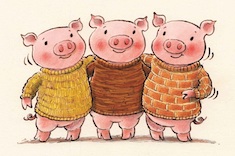I am in a third-grade classroom, the students gather on the rug, and I say, “I heard you have been learning how to think about the texts you are reading. Tell your partner what you know about a literary theme. What is it, and how do you think about it as a reader?”
The students turn toward each other, and I hear, “I don’t know.” “I’m not sure.” Their body language speaks volumes as I see shoulder shrugs and students staring at the ground.
When I get this reaction, I know it is time to abandon my initial plans and “go back to the pigs.”
I respond. “It sounds like this is a good topic for us to learn. When I learn a new way to think, I often go back to a familiar story and try it out there. Then, once I understand, I can try it in new texts. Shall we give it a try?
“Do you know the story of ‘The Three Little Pigs’?” I ask. “The story about the pigs who built houses with straw, sticks, and bricks?”
“Yes!” they shout. “We know that story.” In classroom after classroom in the districts where I teach, “The Three Little Pigs” is a familiar tale.
“Let’s talk about possible themes in ‘The Three Little Pigs.’ The theme is the lesson the characters learn that you could learn too. It is also sometimes called a life lesson or a moral. Let’s try it.
“Think about the details in ‘The Three Little Pigs’ and the problems the characters face. Now, let’s make some interpretations. What lesson do the pigs learn that we could learn too? By the way, I don’t think the lesson is don’t build with straw. I don’t see any straw around here, so that life lesson doesn’t make sense for us. Give it a try. Turn and talk. ‘Maybe one life lesson in “The Three Little Pigs” is . . . One theme might be . . .'”
Now the conversations get a bit louder. “Maybe the lesson is work hard? Take your time? Try your best? Don’t rush?”
“Yes!” Now we are getting somewhere.
Then I reveal a chart and name what the students did.

“Let’s look at this chart to understand the steps you just did in your head. First, we talked out the details and remembered what happened and the decisions the characters make.” I point to the top box. “Then we developed a theory. Maybe the theme is . . . Could it be . . . Do you see how we inferred?” I point to the box on the right-hand side of the chart.
I explain to the students, “The process we just did with ‘The Three Little Pigs’ is what you need to do when you read your books. Start with the details. Then think, What is this character learning that I could learn too? Get an initial idea. Keep reading, or reread. Then you will revise your interpretation. I used to think . . . but now I think. Give it a try, and remember—don’t forget the pigs.”
Going Back to the Pigs with Older Students
In fifth grade, many classrooms explore the genre of fantasy. As they read fantasy, students learn a bit about allegory in text. Now, allegory is a tricky concept for students who are 11 and 12 years old. This is when I “go back to the pigs” again.
“Let’s talk about what allegory means,” I say to the class. “Allegory is a technique writers use. Writers choose characters and places that represent a part of themselves, a historical figure, or a real place.
“Let’s talk about ‘The Three Little Pigs’ and allegory. Was there a time in history when people didn’t have homes and had to go out in the world to find their fortunes? Turn and talk. What do you think?”
“The Depression?” they respond. “The Gold Rush? What about the American Revolution?”
“Was there a person in history who was as evil as the big bad wolf or as smart as the third little pig?”
“Wait. What about Hitler? What about King George? How about Albert Einstein?”
Now we are getting somewhere. Although these interpretations may not be perfect, students are beginning to understand the concept of allegory. As they share their ideas, I point to the interpretation chart and explain that thinking about allegory is another way we grow an idea.
Now, there is nothing magical about “The Three Little Pigs,” except that the students I see know the story. Find a text, song, or video that your students know inside and out, and use it to revisit some of these more difficult literary concepts. When students can practice the literary concept in a familiar text, they get a chance to understand the new idea in a more profound way.
Once they have a frame of reference, they can think about it as they read new texts. For some students, “The Three Little Pigs” represents solid ground that they can rely on when trying out new and abstract ideas. What will be the text you return to again and again?



